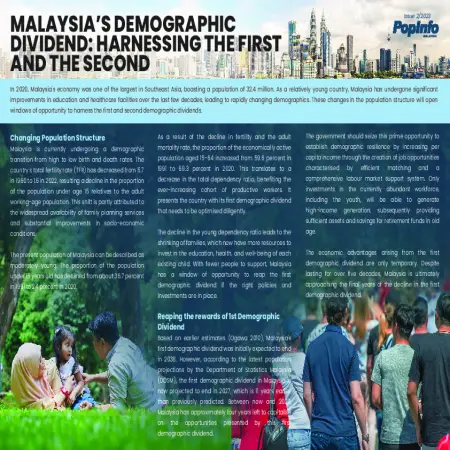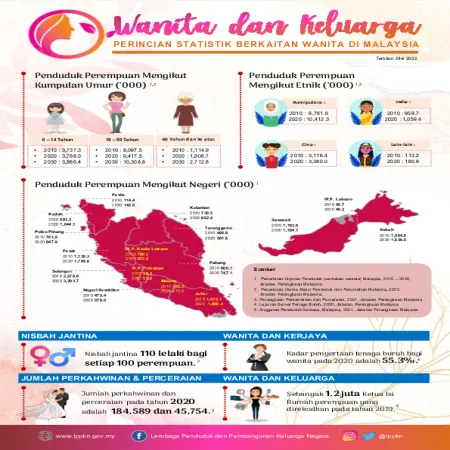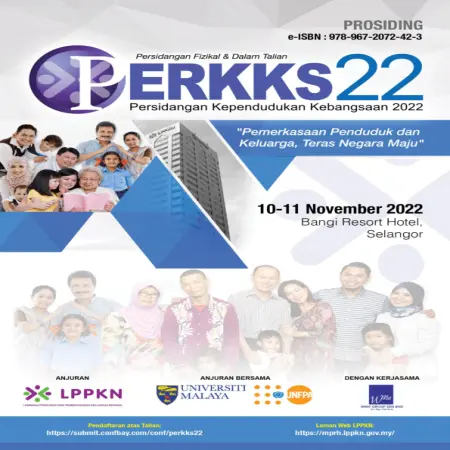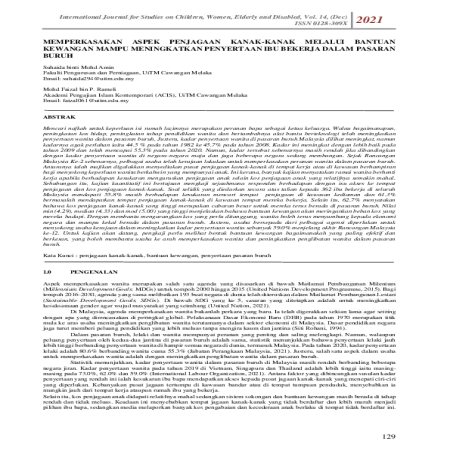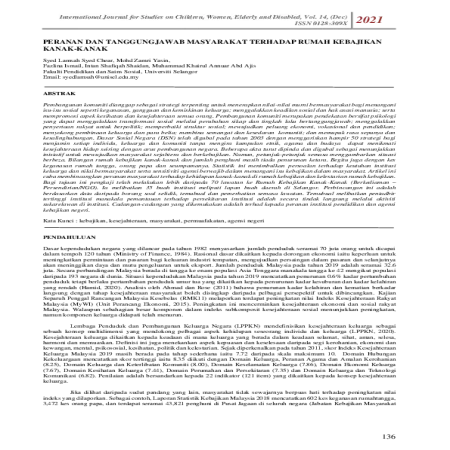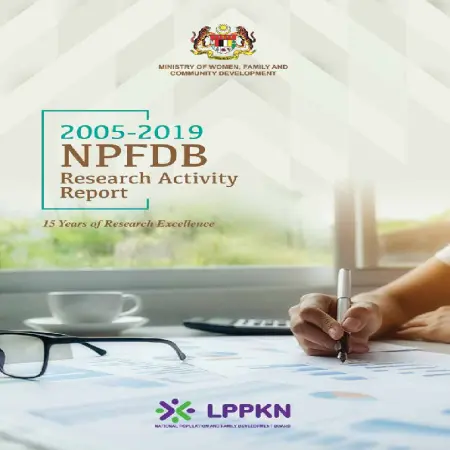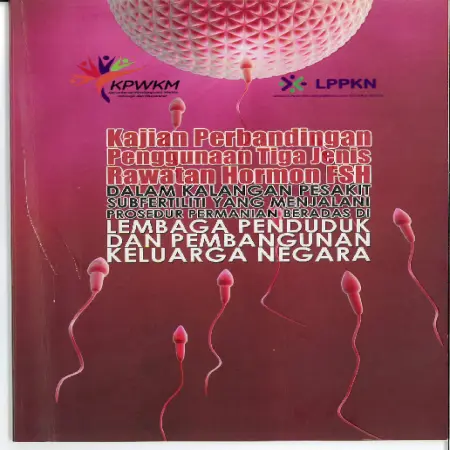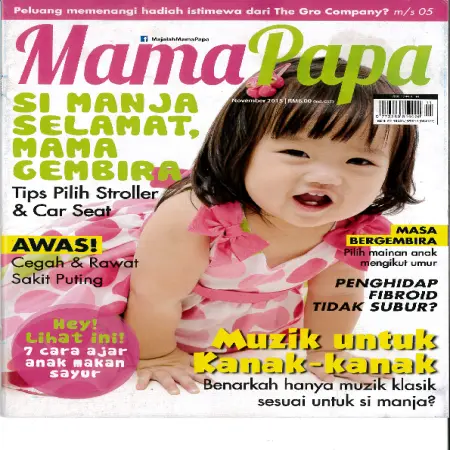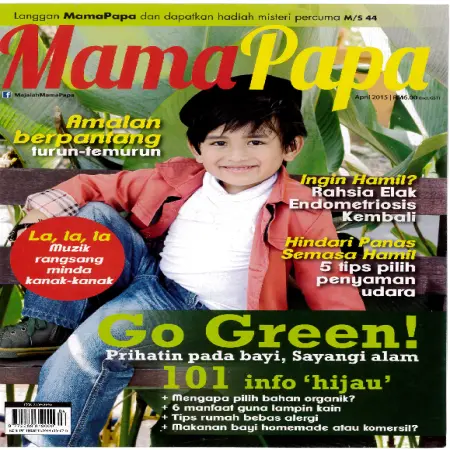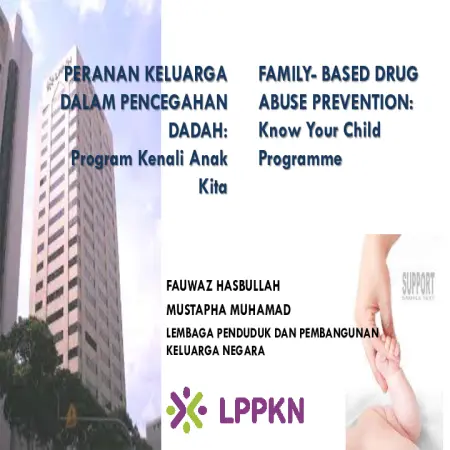TOPICS
Results for Topics : "Childcare"
|
|
Malaysia's demographic dividend: harnessing the first and the second
Item Type: Newsletter
Editor:
Year: 00/12/2023
Abstract: In 2020, Malaysia's economy was one of the largest in Southeast Asia, boasting a population of 32.4 million. As a relatively young country, Malaysia has undergone significant improvements in education and healthcare facilities over the last few decades, leading to rapidly changing demographics. These changes in the population structure will open windows of opportunity to harness the first and second demographic dividends.
|
|
|
|
|
|
Grandparenting in Malaysia: evidence from household surveys
Item Type: Book Section
Editor:
Year: 00/00/2022
Abstract: The lack of childcare facility and support has resulted in fertility decline and low female labour force participation rate in Malaysia, as some women forgo childbearing to focus on career development, while others stop working to look after their children. Grandparents can play a crucial role in childcare, to allow women to combine their maternal role with work. This paper analyses grandparents’ roles in childcare by socio-demographic characteristics.
|
|
|
|
|
|
Memperkasakan aspek penjagaan kanak-kanak melalui bantuan kewangan mampu meningkatkan penyertaan ibu bekerja dalam pasaran buruh
Item Type: Article
Editor:
Year: 00/12/2021
Abstract: Since the 2nd Malaysia Plan in fact, various efforts have been made by the government to empower the role of women in the labour market. One of that is employers are encouraged to provide childcare centers at work or in nearby areas to support the needs of married women with children. This is because, many studies state that many women quit their jobs when faced with difficulties of managing childcare in addition to the relatively increasing cost of childcare. Therefore, this quantitative study aims to examine the extent to which respondents are faced with the issue of access to childcare and the cost of childcare. The survey distributed online to 362 working mothers across Malaysia found that 55.8% still faced difficulties in finding childcare in their residential areas and 61.3% had problems finding childcare in their working area.
|
|
|
|
|
|
Peranan dan tanggungjawab masyarakat terhadap rumah kebajikan kanak-kanak
Item Type: Article
Editor:
Year: 00/12/2021
Abstract: This article tries to discuss the role of society on the lives of children in welfare home and the sustainability of welfare homes. For this purpose, the researcher has made more than 70 visits to Children’s Welfare Homes (Residential – Private/NGO). It involves 35 institutions covering eight districts in Selangor. This discussion is based on data from questionnaires, interviews and observations during visits. Interviews involve the highest administrators of the institution while monitoring the institution’s environment is a direct response through volunteer activities at the institution. The proposals presented are limited to the role of educational institutions and state welfare agencies.
|
|
|
|
|
|
2005-2019 NPFDB research activity report
Item Type: Book
Editor:
Year: 00/00/2019
Abstract: This report highlights the research programmes and activities conducted by NPFDB over the past 15 years. One of the primary functions of NPFDB is to identify, promote and conduct research and studies on population, family development and reproductive health. NPFDB is responsible to advise the government on matters relating to policies and programmes through the findings of research in these three thematic areas. The Board established the Research Committee in 2009 to identify priority research, provide guidance and monitor the research activities in NPFDB. The first Research Committee meeting was held on 13th January 2010 comprising of selected NPFDB Board Members including Associate Professor Tey Nai Peng as Chairman (University of Malaya), Associate Professor Normah Mohd Dali (MARA University of Technology), Datuk Dr. Zulkifli Haji Ismail (Selangor Medical Center), Associate Professor Siti Hawa Ali (University Science Malaysia), Dato’ Dr. Kamaruzaman Ali (FRHAM) and Mr. Lee Wee Min (Focus on the Family) and several division directors of NPFDB.
|
|
|
|
|
|
Kajian perbandingan penggunaan tiga jenis rawatan hormon FSH dalam kalangan pesakit subfertiliti yang menjalani prosedur permanian beradas di Lembaga Penduduk dan Pembangunan Keluarga Negara
Item Type: Research Report
Editor:
Year: 02/01/2017
Abstract: Since 1979, the National Population and Family Development Board (NPFDB) has been providing subfertility management services to the public especially middle-income group. In line with the rapid pace of the latest technology and research developments, there are various types of fertility drugs in the form of injections which had been used in subfertility treatment. The main function of this injection is to mature the follicles where the main hormone contained in this injection is the follicle stimulating hormone (Follicle Stimulating Hormone, FSH). In general, there are three types of FSH injections, which is a recombinant FSH (rFSH) that have 100 percent synthetic hormone, urinary FSH (uFSH) that derived from menopausal urine and highly purified urinary FSH (hp-uFSH) that also derived from menopausal urine but more pure state than uFSH. All three hormones have FSH’s activities but uFSH and hp-uFSH also have Luteinizing Hormone’s activity (LH). Thus, NPFDB has taken initiative to conduct a comparative study on the use of three types of FSH hormone treatment, namely Gonal F (rFSH), Folliova (uFSH) and Menopur (hp-uFSH), among subfertilitie’s patient who’s undergoing Intrauterine Insemination Technique (IUI). Among others, the three types of hormones were studied in terms of effevtivenee and cost burden. The study sample was from patients with unknown cause of subfertilitie’s problem and they visit NPFDB Subfertilitie’s Clinic, Headquarters, from June 2010 to May 2012. The sampling method was random. The patient and researcher do not know the treatment regimen to be initiated until a closed sample containing the treatment regimen code number is opened by the patient before starting treatment. Data were collected, recorded and anlyzed using Statistical Package for the Social Sciences (SPSS) software. Although originally a total of 90 female patients were targeted to be recruited into this study. 30 patients for each type of FSH hormone, but at the end of the study only 39 patients met all eligibility criteria and agreed to participate in this study. The result showed that average of the patients was 28.3 years and the majority were ethnic Malays (76.9%). Most of the patients had a household income between RM 5,000.00 and RM 10,000.00 (51.4%). The percentage of patients requiring more than three injections to procedure mature follicles was lowest for Folliova (41.7%), compared with Menopur (50.0%) and Gonal F (55.6%). Similarly in terms of the number of follicles produced, the Folliova regime (58.3%) produced more follicles (more than three follicles) than other regimes. A total of 16.7 percent of patients who took Menopur injections were confirmed pregnant, while no pregnany occurred among patients who took Folliova and Gonal F. In terms of cost, at the time of this study, the price of three 75IU injections was RM 334.20 for Gonal F, RM 187.20 for Folliova and RM 271.20 for Menopur. In conclusion, this study shows that, hp-uFSH (Menopur) gives the highest pregnancy rate compared to Gonal F and Folliova. Furthemore, the price of Menopur is moderate (affordable) for patients. Therefore, highly purified urinary FSH is a good gonadotropin choice for couples with unexplained subfertility undergoing an IUI procedure and it may be the main choice for patients who need a combination fertility pill stimulation regimen and gonadotropin injections. As a suggestion, such a study should be conducted with a larger sample size to obtain more significant results and be representative of actual population.
|
|
|
|
|
|
Ikat anak: siksa atau keselamatan
Item Type: Article
Editor:
Year: 10/11/2015
Abstract: The average trend in Asia, especially in Malaysia, parents prefer to hold or support the baby on the grounds that it is easier to monitor, breastfeed and put them to sleep. Many parents seem to assume that sitting on their lap is enough to protect their baby from accidents and upset to see a toddler lying tied up in a car seat. Based on statistics, the use of child safety seats and travel systems is not taken seriously by most parents in Malaysia. According to a study conducted by MIROS, babies will be thrown forward at high speeds even if held by an adult during a vehicle collision even with only 30km per hour. Most will be killed as a direct result of the impact.
|
|
|
|
|
|
Selamatkah mainan anak anda?
Item Type: Article
Editor:
Year: 00/04/2015
Abstract: Children's toy can help the educational and developmental process of children at an early age. However, the selection of children's toys needs to be done wisely especially if it involves safety aspects. If parents do not carefully choose toys, it can invite danger to the safety of children. To ensure the safety of children and prevent accidents or unwanted incidents, some things that need to be considered include choosing toys according to the level of age suitability of children, toys not made of toxic materials, avoid toys that contain magnetic materials or batteries to little children and toys that have noise.
|
|
|
|
|
|
Family-based on drug abuse prevention: know your child programme
Item Type: Conference or Workshop Item
Editor:
Year: 00/00/2014
Abstract: This study was to evaluate the effectiveness of the Drug Prevention Program from family perceptive. The respondents was the participants who attended the Know your Child (Kenali Anak Kita) Drug prevention program and sampled by convinence in all the six zones in Malaysia. The aim of this program is to create awareness of family to prevent deviant behaviours, particularly substance abuse among teenagers. The campaign had been implemented phase by phase in six zone involve from various organization, agencies and individual.
|
|
|
|





